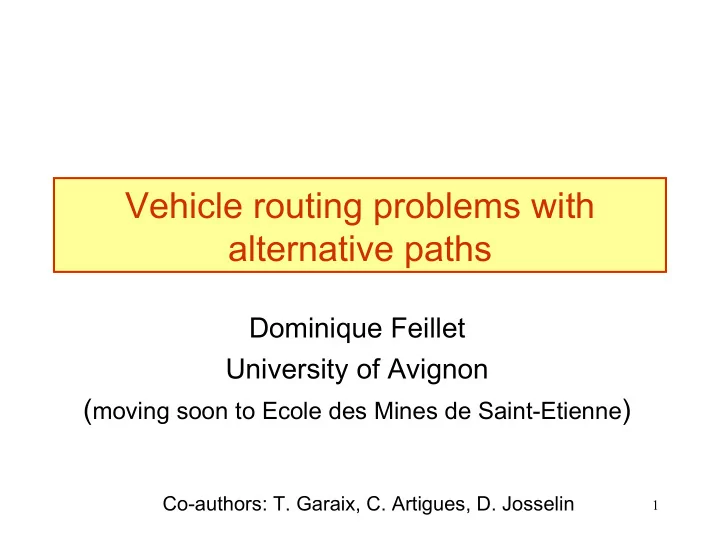

Vehicle routing problems with alternative paths Dominique Feillet University of Avignon ( moving soon to Ecole des Mines de Saint-Etienne ) Co-authors: T. Garaix, C. Artigues, D. Josselin 1
Outline Data modeling in vehicle routing problems Methodological impact of the introduction of alternative paths Practical impact on computing times and quality of results 2
Data collection from a Geographical Information System Too many pieces of information delivered by the GIS every consistent portion of road is described Usual approach for vehicle routing: introduce a vertex for every important location (depot, customer location…) consider the best route between every pair of vertices 3
Limit How to compute the best route between two vertices when arcs are described with more than one attribute? multicriteria shortest path problem the solution is a set of Pareto efficient solutions 4
Illustration: VRPTW From St Olavs Gate To Grefsen-Kjelsas Route A: B 7 kilometers (cost) 15 minutes A Route B: 5 kilometers (cost) 20 minutes 5
Illustration: VRPTW [0,20] [0,20] (7,15) (5,20) [0,30] [0,30] Route Olavs – Grefsen - Olavs 6 Unfeasible Feasible, cost 14 kms
Illustration: VRPTW [0,20] [0,20] (7,15) (5,20) [0,40] [0,40] Route Olavs – Grefsen - Olavs 7 Feasible, cost 10 kms Feasible, cost 14 kms
Multigraph modeling Multigraph G=(V,A) [0,20] V = set of important locations (7,15) An arc (i,j) k exists in A for every pair of vertices (i,j) and every Pareto efficient path P k between i (5,20) and j [0,40] 8
Methodological impact Construction of the graph difficult to find the set of Pareto efficient paths • multicriteria shortest path problem • the set might be of very large size in practice • one can expect a limited number of attributes on arcs • one can expect a set of limited size due to correlations • one can consider a subset of the efficient set (possibly user-defined) 9
Methodological impact Finding the sequence of arcs when the sequence of vertices is known is NP-hard Called Fixed Sequence Arc Selection Problem (FSASP) = Multidimensional Multiple Choice Knapsack Problem Addressed as a shortest path problem with resource constraints (in an acyclic graph) 10
Methodological impact Three complex decisions when solving vehicles routing on multigraphs assign customers to vehicles sequence customers select arcs (FSASP) 11
Methodological impact Heuristic / Metaheuristic Any algorithm can be applied, accepting that evaluating the cost and the feasibility of a solution involves the solution of a FSASP Integer programming Classical models can be adapted, with new decision variables (new flow variables for new arcs…) 12
Computational impact Set of random Euclidean instances for a Dial- A-Ride problem Simple graph Multigraph* Best insertion Exact Best insertion Exact -17% VALUE 12% 0% -8% * : generated from a simple graph with 10% of additional arcs about 30% cheaper and slower ; results in a graph with up to 10 times more arcs 13
Computational impact Set of realistic instances (computed from a GIS) for a Dial-A-Ride problem in a rural zone Simple graph Multigraph* Best insertion Exact Best insertion Exact -8% VALUE 12% 0% 2% * : up to 10 times more arcs, with arcs up to 50% cheaper or slower 14
Some improvements Best insertion Find the best neighbor with the solution of a single Shortest Path Problem with Resource Constraints • add a vertex for every possible insertion location • add a binary resource that imply to visit exactly one of these vertices possible insertion locations: initial sequence: 15
Some improvements Exact method Branch and Price The multigraph only impacts: • the subproblem: extend labels with every outgoing arcs • the branching rule: select or forbid a successor (i.e., a set of parallel arcs) 16
Computational impact Set of random Euclidean instances for a Dial- A-Ride problem Simple graph Multigraph* Best insertion Exact Best insertion Exact -17% VALUE 12% 0% -8% 1000s TIME 0s 100s 10s * : generated from a simple graph with 10% of additional arcs about 30% cheaper and slower ; results in a graph with up to 10 times more arcs 17
Computational impact Set of realistic instances (computed from a GIS) for a Dial-A-Ride problem in a rural zone Simple graph Multigraph* Best insertion Exact Best insertion Exact -8% VALUE 12% 0% 2% 1000s TIME 0s 100s 2s * : up to 10 times more arcs, with arcs up to 50% cheaper or slower 18
Other improvements Exact method When solving the subproblem, replace set of arcs (i,j) k with a single idealized arc (i,j) • c(i,j) = min {c((i,j) k ) • t(i,j) = min {t((i,j) k ) A set of promising vertex-sequences are obtained Solve the FSASP on these sequences and only keep the feasible routes of negative reduced cost If no route is obtained, solve the original subproblem 19
Conclusion Improving the completeness of the data is a real issue A very simple heuristic can beat an exact method with the multigraph representation An « automatic » adaptation of the algorithms looks simple most of the times (once the FSASP tool is developed) Some possibilities exist to really consider the multigraph issue in the algorithms 20
Perspectives Evaluate this modeling in other contexts Multimodal transportation (time, cost) Transportation with congestion (time, cost) Tourist tours (time, scenic interest) Implement more efficient algorithms 21
Recommend
More recommend